In my last two posts on Islamabad (here and here) I talked about the woods and the forest trails that I love so much and take to them whenever I can.
In those woods, at the foot of the Margallas, until a few years ago, there was a very large and very old tree, believed to be several hundred years old. Its gnarled branches sprawled like an umbrella over a very large area around the tree.
It was a pipal tree (ficus religiosa). Pakistani residents of Islamabad were generally unaware of the significance of this tree. But the tree attracted many expatriate residents, mostly from South East or East Asian diplomatic missions in Islamabad. They would come and simply contemplate the tree and its surroundings. Someone had even a built a concrete kiosk and a concrete bench next to the tree for visitors to sit. The tree was believed to be a Bodhi tree.
What is a bodhi tree and how it came to be in Islamabad?
As many of us would remember from our history books, that is, if one graduated before the 1970s, for afterwards they stopped teaching history of pre-Muslim era of the subcontinent in schools, prince Siddhartha Gautuma meditated under an old pipal tree in Gaya, a village near Patna, Bihar, some 2,500 years ago. Ultimately he achieved nirvana, or was “awakenedâ€.
Consequently, the tree under which he sat was named Bodhi, meaning “awakening.†Sidhartha Gautuma became Buddha (the awakened) and the village came to be known as Bodh Gaya, the name it still carries today. The Bhodi tree that grows in Bodh Gaya today is believed to be a direct offspring of the original Bhodi tree.
In the centuries after Buddha, the Bodhi tree became a symbol of Buddha’s presence and an object of devotion for Buddhists.
A little more history before I get to the pipal tree in the woods of Islamabad.
King Ashoka (died 232 BC), the third Maurian king, converted to Buddhism and became a great advocate of the religion and actively propagated Buddhism throughout his empire. The Mauran Empire included, other than the present Northern India, the Gandhara region, which included the area around present day Islamabad, the Peshawar valley and parts of Afghanistan and Iran. Taxila (then Taxshashila), Peshawar (then Parshpura) and Charsaddah (then Pushklavati) were important cities of Gandhara. It was at this time that Taxila reached the peak of its development and became the center of Buddhism. Chandra Gupta Mauria and Asoka spent time at Taxila and so did their famous political adviser, Chanakya, who taught at Taxila.
King Asoka’s daughter, Sanghamitra, who became a Buddhist nun, is said to have taken a cutting of the Bohdi tree from Bhod Gaya to Sri Lanka and planted it at Anaradapura, the ancient capital of the island, where it still grows. Many temples throughout the Buddhist world have bodhi trees growing in them, which are or are believed to be offspring of the one from Anaradapura.
Now, back to Islamabad.
The old pipal tree that grew in the woods of Islamabad was also believed to be “descendent” of the Bodhi tree in Gaya, possibly planted, centuries ago, by a devotee, alongside a temple that might have existed there. Taxila, as the crow flies, is only a few miles from Islamabad, and is full of Buddhist monuments – stupas, statues and remains of monasteries.
In the 1980s, Ziaul Haq ruled Pakistan. In his zeal to “Islamize†the country, he encouraged and helped build madrassas all over the country, many with Saudi money. One such madrassa was built in the woods of Islamabad, not far from where the Bodhi tree stood. Over the years, the madrassa expanded, as most madrassas do, violating the building codes and encroaching upon state land, to become one of the largest madrassas in Islamabad. Today, it occupies 5-7 acres of prime real estate in Islamabad and has a sprawling building complex, and a very large playing field – probably larger than any school or college in Islamabad might have.
The madrassa houses a couple of thousand students ranging in age from 6 to 26, or even older. One sees them during breaks in their classes when they swarm into the playground and overrun the nearby children’s park, driving the children and women out. It is a bizarre sight to see young bearded men swinging and sliding on the swings and slides meant for children. Other contributions of these madrassa students to the community are: street signs defaced with posters soliciting sacrificial animal skins, and vandalized letterboxes.
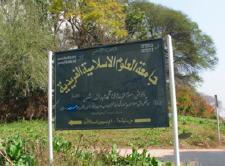
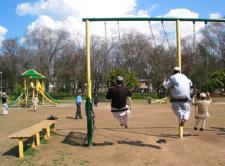
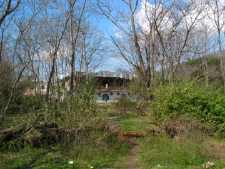

Fortunately, because of its very large girth, the Bodhi tree did not burn down completely even though it was badly damaged. It survived with half of its branches still intact. The city administration tried to preserve what was left of the tree. They even posted guards at the site for sometime after the incident to protect the tree from any further attacks. When I saw it last, a few years ago, it was still green and seemed as if it was struggling to recover from the wounds inflicted upon it.
Last week, having returned to Islamabad after two years, I decided to look up the tree, as if you would look up an old friend, and see how it was doing. I was shocked. There was no tree there! Only a few logs of the decapitated tree were lying around like dead bodies. The concrete kiosk next to it was partially demolished, its remaining walls covered with graffiti, and the bench was gone. Through the woods, I could also see the madrassa, some construction work going on it. Still expanding, I guess.



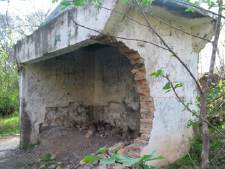
(All pictures, except the first, by the author)
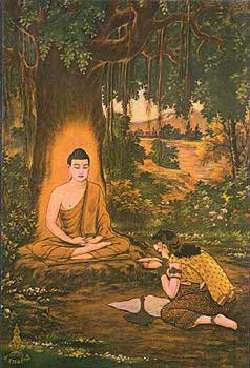




















































This is an excellent blog. The “liteness” of the articles even while discussing very serious issue is amazing. Descent of a society which can neither save nor tolerate an innocuous Bodhi tree is depicted in a thought provoking manner. Pervaiz Munir Alvi made a valid point on Hinduasm absorbing other small religion in its fold, to avoid such incidents.
In India, the Hinduism always absorbed goodness of every other culture that it came across. Rig veda says “may noble thought come to us from all
the direction”. No doubt it absorbs the religions such as Buddism in its fold.
The influence of Sufism is all to see. Our “bhajans” and for that matter the whole “Bhakti” movement is the result of influence of Sufism.
Many Christian in India call their Bible as ‘Satyaveda” in line with Vedas, sacred to Hindus. One recently build church in south Indian sate Kerala, welcome you not by a holy cross, but by “Om”, the most sacred symbol, syllable and all that represent Hinduism. Upanishad says ” Whoever knows this syllable, obtains all that he desires”. I saw in another church, the Christ sitting in Gautama Buddha’s posture beneath a Bodhi tree!
I accidentally stumbled upon this forum while googling and found it very interesting. Here is my two cents: I refer to posts by Pervaiz Munir Alvi and Ahsan above regarding India, Buddhism, Islam and Hinduism. I am a Hindu Indian and concur with a lot of what they say. I lived in India until recently and still visit so i guess I’m in touch with the pulse. Ahsan questions whether smaller religions of India will be absorbed into Hinduism. This is unlikely to happen, but it certainly is a two way give-take street. Hinduism imparts and absorbs, which is probably why other faiths feel less threatened in India. I have seen Indian “Hindus” absorb features from other faiths. I have also seen people from other faiths absorb essentially Hindu customs. As an example, I know several Muslim and Christian families whose women wear the “mangalsutra” or “Taali” to indicate their married status. Similarly I get to see people from all religions visit certain dargahs, temples and churches in an atmosphere of great faith. Little customs like taking the blessings of elders by prostrating before them or touching their feet before venturing out on an important chore etc also have been adopted by many faiths. These are little examples that came to mind. Hinduism is more a way of life than a religion per se and I see that it evolving and encompassing while “letting” (for want of a better word) other religions thrive side by side.
Related somewhat to the subject of this post, this from Daily Times today:
Pervaiz Munir Alvi said: “It is just that Pakistanis are trying to point out theirs on this post in a hope of self betterment. I for one appreciate your interest in Pakistani society. Please do tell us where we go wrong; in a positive way though. ”
Pervaiz Munir Alvi: Let us start with patronizing smugness son endemic among some Pakis if you have decided to looks at the “wrongs” in a positive way.
@Bhindigosht,
Yes, occasionally I do talk to them when I come across them during their breaks. Like the other day I talked to a 9 year old Sa’d from a village called Attar Sheesha, short of Balakot. He said he was a Hifz student(memorizing Quran) — a 3 to 4 year course as opposed to 8 year aalim course. He said, they wake up at about 5 in the morning, do the namaz, then breakfast, then hifz for a couple of hours, a short break, more hifz, sleep for two hours, more hifz, early lunch, more hifz … and it goes on. They get a long break of one and half hour before sunset and then maghrib prayer, some more hifz, Isha prayer, dinner and bed. Wake up at 5 next morning and so on — for three or four years.
Do they get punished? Yes, occasionally. Why? when they talked to each other during hifz or when they made a memorizing mistake. How are they punished? With a “pipe”, Sa’d said innocently. Pipe! What pipe? What he meant was rubber hose. Any other punishment? Yes, sometime they are made to sit like a “kursi” (chair). How? You are ordered to sit as you were sitting on a chair with your back against the wall, and your thighs horizontal. He even demonstrated how and sat without any effort. I tried it too but fell on my bottoms before I could count up to 10.
Did he like Islamabad or Attar Sheesha? Islamabad is nice but too much fahashi, said the 9 year old. What kind of fahashi? Young women sitting in the cars with men.
There are so many other interesting details that give a peek into the lives of these students but it would require a separate post.